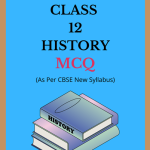NCERT Class 12 History MCQ Chapter 14 Understanding Partition Solutions to each chapter is provided in the list so that you can easily browse through different chapters NCERT Class 12 History MCQ Chapter 14 Understanding Partition and select need one. NCERT Class 12 History MCQ Chapter 14 Understanding Partition Question Answers Download PDF. NCERT History MCQ Class 12 Solutions.
NCERT Class 12 History MCQ Chapter 14 Understanding Partition
Also, you can read the NCERT book online in these sections Solutions by Expert Teachers as per Central Board of Secondary Education (CBSE) Book guidelines. CBSE Class 12 History MCQ Solutions are part of All Subject Solutions. Here we have given NCERT Class 12 History MCQ Part – I: Themes in Indian History, History MCQ Part – II: Themes in Indian History, History MCQ Part – III: Themes in Indian History. NCERT Class 12 History MCQ Chapter 14 Understanding Partition Notes, NCERT Class 12 History MCQ Notes for All Chapters, You can practice these here.
Understanding Partition
Chapter: 14
| THEMES IN INDIAN HISTORY (PART – III) |
| MCQ |
1. The Name Paki-stan or Pakistanis coined by a Punjabi Muslim student at Cambridge in year 1933, he was:
(a) Choudhry Rehmat Ali.
(b) Mohd. Iqbal.
(c) Mohd. Ali Jinnah.
(d) Sir Syed Ahmad Shah.
Ans: (a) Choudhry Rehmat Ali.
2. Lucknow Pact was signed between Congress and Muslim League in:
(a) January 1918.
(b) December 1916.
(c) February 1917.
(d) March 1918 3.
Ans: (b) December 1916.
3. About Arya Samaj the correct statement’s are:
(a) It was a North Indian Hindu reform organisation of the late 19th and early 20th centuries.
(b) Arya Samaj was particularly active in the Punjab.
(c) This organisation sought to revive vedic learning and combine it with modern education in the sciences.
(d) All of the above.
Ans: (d) All of the above.
4. The muslim League was initially floated in:
(a) Delhi.
(b) Dhaka.
(c) Bombay.
(d) Calcutta.
Ans: (b) Dhaka.
5. The muslim League was founded in year:
(a) 1908.
(b) 1905.
(c) 1907.
(d) 1906.
Ans: (d) 1906.
6. Hindu Mahasabha was founded in:
(a) 1911.
(b) 1915.
(c) 1919.
(d) 1939.
Ans: (b) 1915.
7. Unionist Party before partition was very popular and powerful in:
(a) Landholders, in the Punjab.
(b) Educated youths, in Bihar.
(c) Working classes, in Bengal.
(d) None of them.
Ans: (a) Landholders, in the Punjab.
8. The meaning of word/term-secede is:
(a) to support to an association ororganisation.
(b) to withdraw formally from an association or organisation.
(c) to leave a parental country for ever.
(d) None of the above.
Ans: (b) to withdraw formally from an association or organisation.
9. Consider the following statements regarding the partition of British India:
I. Several hundred thousand people were killed and innumerable women raped and abducted.
II. Millions were uprooted, transformed into refugees in alien lands.
III. Probably, some 15 million had to move across hastily constructed frontiers separating India and Pakistan.
Which of the following statement(s) is/ are correct?
(a) Only I.
(b) I and II.
(c) I and III.
(d) All of the Above.
Ans: (d) All of the Above.
10. In which of the following year, elections to the provincial legislatures were held for the first time?
(a) 1906.
(b) 1918.
(c) 1937.
(d) 1947.
Ans: (c) 1937.
11. Who has given the two nation-theory?
(a) Mahatma Gandhi.
(b) Muhammad Ali Jinnah.
(c) Sardar Ballabh Bhai Patel.
(d) Jawaharlal Nehru.
Ans: (b) Muhammad Ali Jinnah.
12. Who is the author of the book “The Other Side of Silence”?
(a) Khuswant Rai.
(b) Urvashi Butalia.
(c) Khushdeva Singh.
(d) Mahatma Gandhi.
Ans: (b) Urvashi Butalia.
13. “Sare Jahan se Achha Hindustan Hamara”, was written by famous poet:
(a) Mohhamad Iqbal.
(b) Abdul Gaffar Khan.
(c) Rehman.
(d) Sir Syed Ahmed Khan.
Ans: (a) Mohhamad Iqbal.
14. The Arya Samaj took efforts to bring back those who recently converted to Islam through:
(a) Atma Movement.
(b) Karma Movement.
(c) Shakthi Movement.
(d) Shuddhi Movement.
Ans: (d) Shuddhi Movement.
15. The proposals for the partition of India into India and Pakistan were contained in the:
(a) Cabinet Mission Proposals.
(b) Cripps Mission Proposals.
(c) Mountbatten Plan of 3rd June, 1947.
(d) Prime Minister Attlee’s statement of 20th February, 1947.
Ans: (c) Mountbatten Plan of 3rd June, 1947.

Hi! my Name is Parimal Roy. I have completed my Bachelor’s degree in Philosophy (B.A.) from Silapathar General College. Currently, I am working as an HR Manager at Dev Library. It is a website that provides study materials for students from Class 3 to 12, including SCERT and NCERT notes. It also offers resources for BA, B.Com, B.Sc, and Computer Science, along with postgraduate notes. Besides study materials, the website has novels, eBooks, health and finance articles, biographies, quotes, and more.




